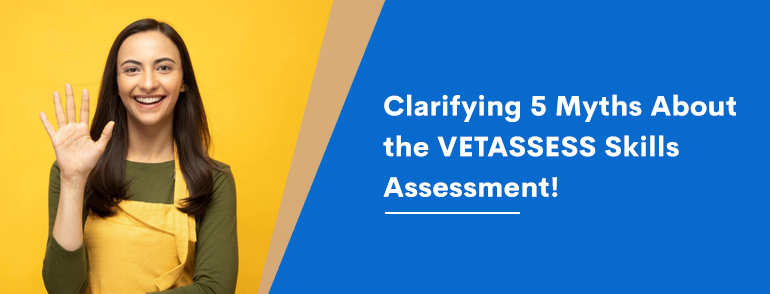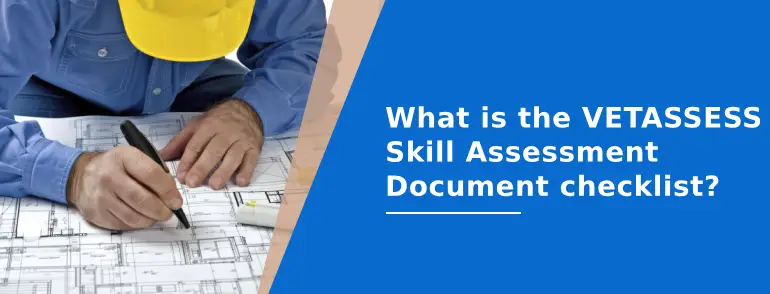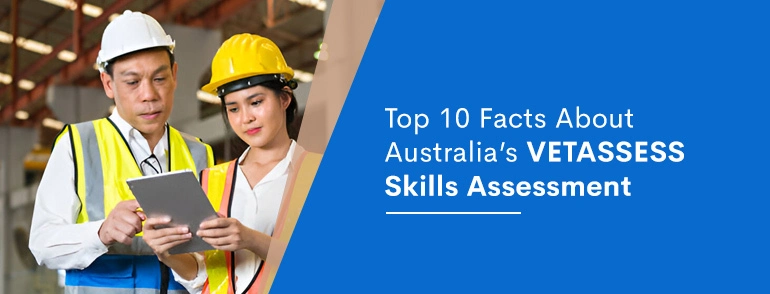Are you considering migrating to Australia and need to undergo the VETASSESS skills assessment? Aspiring immigrants often find themselves encountering a myriad of pieces of information about the process, some of which can be misleading or downright incorrect.
VETASSESS stands for Vocational Education and Training Assessing Services. The VETASSESS skills assessment is a crucial step for many individuals seeking to work or migrate to Australia.
It’s a skills assessment organization, not just an assessment itself. They have been authorized by the Australian Government to evaluate a diverse range of trades, professions, and specialized occupations.
To prepare for the assessment, you need to review the documents, understand the criteria for your occupation, gather the required documents, and consider using a migration agent for guidance
Here’s a breakdown of what a VETASSESS assessment involves:
- Skills and Qualification Evaluation: They assess your qualifications (degrees, diplomas, and certificates) to ensure they meet the Australian Qualifications Framework (AQF) standards.
- Work Experience Assessment: They also evaluate your work experience to determine its relevance and skill level concerning your chosen occupation in Australia.
- Migration Pathway: A positive VETASSESS assessment is a crucial step for many skilled migration pathways to Australia. It essentially verifies that you have the skills and knowledge to work in your chosen field within the Australian context.
5 Myths About the VETASSESS Skills Assessment
The VETASSESS Skills Assessment is likely a hurdle you’ll need to overcome. But don’t let myths and misconceptions hold you back! Here, we debunk five common myths surrounding the VETASSESS assessment, empowering you to navigate the process with confidence.

Myth #1: VETASSESS is Only for Fresh Graduates
New graduates might be the first to come to mind, but the VETASSESS assessment applies to anyone seeking to work in a skilled profession in Australia, regardless of experience. Whether you’re a seasoned professional or just starting, VETASSESS evaluates your skills and qualifications against Australian benchmarks.
So, what’s the good news? Extensive experience can be a valuable asset! By providing strong evidence of your work history and its relevance to Australian standards, you can demonstrate your competency and increase your chances of a positive VETASSESS skills assessment.
While it’s true that VETASSESS is well-known for assessing trade occupations, such as carpenters, electricians, and plumbers, it’s not exclusive to these professions. VETASSESS also assesses a wide range of non-trade occupations across various industries, including IT, engineering, healthcare, and management.
So, regardless of your profession, if your occupation is listed on the Skilled Occupations List (SOL) or Consolidated Sponsored Occupations List (CSOL), you may need a VETASSESS assessment.
Read More: Facts of Australia’s VETASSESS Skills Assessment. 😎🧠
So, Who Needs a VETASSESS Assessment?
If you’re aiming to migrate to Australia and work in a skilled profession, you might need a VETASSESS assessment. This applies to a wide range of occupations, but some common examples include:
- Engineers
- Accountants
- IT Professionals
- Nurses
- Tradespeople (carpenters, electricians, plumbers, etc.)
Myth #2: A Negative Assessment Means No Migration
A negative VETASSESS outcome doesn’t have to derail your migration dreams. The process offers an appeals mechanism, allowing you to challenge the decision with additional evidence or clarifications. Additionally, a negative assessment can be a valuable roadmap.
It highlights skill gaps you might need to address. Consider this an opportunity to upskill through relevant courses or certifications, making your future application even stronger. Also, while a positive VETASSESS skills assessment is undoubtedly a significant milestone in your visa application journey, it doesn’t guarantee visa approval.
The Department of Home Affairs makes the final decision on visa applications, taking into account various factors beyond the skills assessment, such as health and character requirements.
Additionally, some visa subclasses require sponsorship or nomination by an Australian employer, which adds another layer of complexity to the process. A VETASSESS assessment is just one piece of the puzzle, albeit an important one.
Read more: Statutory Declarations and Affidavits for VETASSESS Skill Assessment. 😄😁
Myth #3: VETASSESS is a Financial and Time Black Hole
The cost and timeline associated with a VETASSESS assessment can be a concern. While there are fees involved, planning and preparation can help you manage them effectively. Research the assessment costs upfront (visit the VETASSESS migration skills assessment guide) and factor them into your migration budget.
Streamline the process by gathering required documents efficiently (using a VETASSESS skills assessment checklist) and ensuring they meet VETASSESS specifications. This can minimize delays and potential additional costs.
Myth #4: VETASSESS Only Recognizes Specific Qualifications
Don’t get fixated on specific degrees or diplomas. VETASSESS focuses on assessing your skills against the Australian competency standards for your chosen occupation.
International qualifications can be recognized through VETASSESS, and your relevant work experience can play a significant role. Explore Recognition of Prior Learning (RPL) options if your experience directly translates to the Australian context.
Another common misconception is that the VETASSESS skills assessment is necessary only for individuals applying for permanent residency through skilled migration programs like the General Skilled Migration (GSM) visa subclass 189 or subclass 190.
However, this assessment is also required for various temporary work visas, such as subclass 482 (Temporary Skill Shortage visa) and subclass 186 (Employer Nomination Scheme visa). So, whether you’re aiming for permanent residency or a temporary work visa, a VETASSESS assessment might be in your future.
Myth #5: You’re Powerless to Influence the Outcome
You have more control over your VETASSESS journey than you might think! Start by thoroughly understanding the assessment criteria for your specific occupation (use the VETASSESS requirements for your Occupation keywords). Gather strong evidence that showcases your skills and experience.
This could include work references, transcripts, project portfolios, or relevant certifications. Consider seeking guidance from a migration agent who can help navigate the complexities of the process and ensure your application is well-presented.
Read More: Common mistakes to be avoided in the VETASSESS Skills Assessment. 🔥😎
The VETASSESS Skills Assessment is a crucial step in your Australian migration journey. By debunking these common myths and taking a proactive approach, you can increase your chances of a positive outcome.
Remember, preparation is key! With the right information and resources, you can confidently conquer the VETASSESS assessment and pave the way for a successful skilled migration to Australia.
Conclusion
The VETASSESS skills assessment is a crucial step for many individuals seeking to work or migrate to Australia. By debunking these common myths, we hope to provide clarity and reassurance to those embarking on this journey.
Remember to do your research, seek professional assistance if needed, and approach the process with patience and persistence. With the right approach and preparation, you can successfully navigate the VETASSESS skills assessment and take a significant step toward realizing your Australian dream.
The VETASSESS Skills Assessment might seem like a daunting hurdle, but with the right information and preparation, you can approach it with confidence. Remember, you’re not alone in this journey. Utilize the resources available, including the VETASSESS website and migration professionals, to guide you through the process.
Don’t be discouraged by myths or misconceptions. Understanding the assessment criteria, gathering strong evidence, and potentially seeking professional guidance can significantly increase your chances of a positive VETASSESS outcome. Take the first step towards fulfilling your Australian migration dreams by preparing for your VETASSESS assessment today!
The VETASSESS Skills Assessment is a crucial step in your Australian migration journey. By debunking these common myths and taking a proactive approach, you can increase your chances of a positive outcome.
Remember, preparation is key! With the right information and resources, you can confidently conquer the VETASSESS assessment and pave the way for a successful skilled migration to Australia.
Read More: Learn about handling VETASSESS feedback and Possible Outcomes. 🔥🔥
FAQs
- What is a VETASSESS assessment?
It’s an assessment of your qualifications and work experience for migrating to Australia and working in a skilled profession.
- What documents are required for a VETASSESS assessment?
The specific documents required for a VETASSESS assessment will vary depending on your circumstances. However, you can find a comprehensive list of required documents on the VETASSESS website.
- How long does the VETASSESS assessment process take?
The processing time for a VETASSESS assessment can vary depending on the complexity of your application and your current workload.
- What are the common challenges people face during a VETASSESS assessment?
While the VETASSESS assessment process is straightforward, gathering the required documents and ensuring they meet VETASSESS specifications can be a challenge. This is why carefully reviewing the requirements and following the VETASSESS checklist can help avoid delays..
- What happens after the assessment?
You’ll receive a positive, negative, or “needs more information” outcome.
By addressing these myths and providing helpful resources, this blog aims to empower you on your Australian migration journey.




